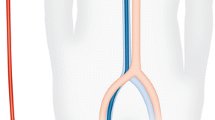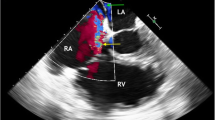Abstract
Veno-venous extracorporeal membrane oxygenation (VV-ECMO) is a form of extracorporeal life support that provides total gas exchange (CO2 and O2) within the central venous circulation. The bicaval dual lumen cannula (DLC) is an option for patients requiring respiratory support with VV-ECMO. The catheter is inserted via the internal jugular vein into the superior and inferior vena cava, drains blood into the ECMO circuit for gas exchange, and then returns arterialized blood to the right heart for circulation. The DLC facilitates physical therapy, ambulation, and early extubation. This chapter will review the uses, advantages, and unique complications of the DLC.


Similar content being viewed by others
References
Extracorporeal Life Support Organization (ELSO). General guidelines for all ECLS cases. August 2017. https://www.elso.org/Resources/Guidelines.aspx. Accessed June 12 2019.
Makdisi G, Wang IW. Extra Corporeal Membrane Oxygenation (ECMO) review of a lifesaving technology. J Thorac Dis. 2015;7:E166–76.
Lorusso R, Alexander P, Rycus P, Barbaro R. The extracorporeal life support organization registry:update and perspectives. Ann Cardiothorac Surg. 2019;8:93–8.
ECMO. Registry of the Extracorporeal Life Support Organization (ELSO). Ann Arbor: Michigan; April, 2019.
Bartlett RH, Gazzaniga AB, Toomasian J, Coran AG, Roloff D, Rucker R. Extracorporeal membrane oxygenation (ECMO) in neonatal respiratory failure. 100 cases. Ann Surg. 1986;204:236–45.
Bartlett RH, Roloff DW, Cornell RG, Andrews AF, Dillon PW, Zwischenberger JB. Extracorporeal circulation in neonatal respiratory failure: a prospective randomized study. Pediatrics. 1985;76:479–87.
O'Rourke PP, Crone RK, Vacanti JP, et al. Extracorporeal membrane oxygenation and conventional medical therapy in neonates with persistent pulmonary hypertension of the newborn: a prospective randomized study. Pediatrics. 1989;84:957–63.
No authors listed. UK collaborative randomised trial of neonatal extracorporeal membrane oxygenation. UK Collaborative ECMO Trail Group. Lancet. 1996;348:75-82.
Anderson HL, Otsu T, Chapman RA, Barlett RH. Venovenous extracorporeal life support in neonates using a double lumen catheter. ASAIO Trans. 1989;35:650–3.
Harvey C. Cannulation for Neonatal and Pediatric Extracorporeal Membrane Oxygenation for Cardiac Support. Front Pediatr. 2018;6:17.
Zwischenberger JB, Toomasian JM, Drake K, Andrews AF, Kolobow T, Bartlett RH. Total respiratory support with single cannula venovenous ECMO: double lumen continuous flow vs. single lumen tidal flow. Trans Am Soc Artif Intern Organs. 1985;31:610–5.
Andrews AF, Zwischenberger JB, Cilley RE, Drake KL. Venovenous extracorporeal membrane oxygenation (ECMO) using a double-lumen cannula. Artif Organs. 1987;11:265–8.
Otsu T, Merz SI, Hultquist KA, et al. Laboratory evaluation of a double lumen catheter for venovenous neonatal ECMO. ASAIO Trans. 1989;35:647–50.
Anderson HL, Snedecor SM, Otsu T, Barlett RH. Multicenter comparison of conventional venoarterial access versus venovenous double-lumen catheter access in newborn infants undergoing extracorporeal membrane oxygenation. J Pediatr Surg. 1993;28:530–4.
Delius R, Anderson H, Schumacher R, et al. Venovenous compares favorably with venoarterial access for extracorporeal membrane oxygenation in neonatal respiratory failure. J Thorac Cardiovasc Surg. 1993;106:329–38.
Gauger PG, Hirschl RB, Delosh TN, Dechert RE, Tracy T, Bartlett RH. A matched pairs analysis of venoarterial and venovenous extracorporeal life support in neonatal respiratory failure. ASAIO J. 1995;41:M573–9.
Zwischenberger JB, Nguyen TT, Upp JR, et al. Complications of neonatal extracorporeal membrane oxygenation. Collective experience from the extracorporeal life support organization. J Thorac Cardiovasc Surg. 1994;107:838–48.
Wang D, Zhou X, Liu X, Sidor B, Lynch J, Zwischenberger JB. Wang-Zwische double lumen cannula-toward a percutaneous and ambulatory paracorporeal artificial lung. ASAIO J. 2008;54:606–11.
Davies A, Jones D, Bailey M, et al. Extracorporeal membrane oxygenation for 2009 influenza A(H1N1) acute respiratory distress syndrome. JAMA. 2009;302:1888–95.
Noah MA, Peek GJ, Finney SJ, et al. Referral to an extracorporeal membrane oxygenation center and mortality among patients with severe 2009 influenza A(H1N1). JAMA. 2011;306:1659–68.
Peek GJ, Mugford M, Tiruvoipati R, et al. Efficacy and economic assessment of conventional ventilatory support versus extracorporeal membrane oxygenation for severe adult respiratory failure (CESAR): A multicentre randomised controlled trial. Lancet. 2009;374:1351–63.
Bermudez CA, Rocha RV, Sappington PL, Toyoda Y, Murray HN, Boujoukos AJ. Initial experience with single cannulation for venovenous extracorporeal oxygenation in adults. Ann Thorac Surg. 2010;90:991–5.
Javidfar J, Brodie D, Wang D, et al. Use of bicaval dual-lumen catheter for adult venovenous extracorporeal membrane oxygenation. Ann Thorac Surg. 2011;91:1763–8.
Zamora IJ, Shekerdemian L, Fallon SC, et al. Outcomes comparing dual-lumen to multisite venovenous ECMO in the pediatric population: The extracorporeal life support registry experience. J Pediatr Surg. 2014;49:1452–7.
Abrams D, Brodie D. Emerging indications for extracorporeal membrane oxygenation in adults with respiratory failure. Ann Am Thorac Soc. 2013;10:371–7.
Taccone FS, Malfertheiner MV, Ferrari F, et al. Extracorporeal CO2 removal in critically ill patients: A systematic review. Minerva Anestesiol. 2017;83:762–72.
Gattinoni L, Kolobow T, Agostoni A, et al. Clinical application of low frequency positive pressure ventilation with extracorporeal CO2 removal (LFPPV-ECCO2R) in treatment of adult respiratory distress syndrome (ARDS). Int J Artif Organs. 1979;2:282–3.
Morris AH, Wallace CJ, Menlove RL, et al. Randomized clinical trial of pressure-controlled inverse ratio ventilation and extracorporeal CO2 removal for adult respiratory distress syndrome. Am J Respir Crit Care Med. 1994;149:295–305.
Abrams DC, Brenner K, Burkart KM, et al. Pilot study of extracorporeal carbon dioxide removal to facilitate extubation and ambulation in exacerbations of chronic obstructive pulmonary disease. Ann Am Thorac Soc. 2013;10:307–14.
Brenner K, Abrams DC, Agerstrand CL, Brodie D. Extracorporeal carbon dioxide removal for refractory status asthmaticus: experience in distinct exacerbation phenotypes. Perfusion. 2014;29:26–8.
Schneider TM, Bence T, Brettner F. “Awake” ECCO2R superseded intubation in a near-fatal asthma attack. J Intensive Care. 2017;5:53.
Lynch W. ECLS Cannulation for adults with respiratory failure. In: Brogan T, editor. Extracorporeal life support: The ELSO red book. Ann Arbor: ELSO; 2017. p. 429–36.
Schmid C, Philipp A, Hilker M, et al. Venovenous extracorporeal membrane oxygenation for acute lung failure in adults. J Heart Lung Transplant. 2012;31:9–15.
Goligher EC, Tomlinson G, Hajage D, et al. Extracorporeal membrane oxygenation for severe acute respiratory distress syndrome and posterior probability of mortality benefit in a post hoc bayesian analysis of a randomized clinical trial. JAMA. 2018;320:2251–9.
Fuehner T, Kuehn C, Hadem J, et al. Extracorporeal membrane oxygenation in awake patients as bridge to lung transplantation. Am J Respir Crit Care Med. 2012;185:763–8.
Bacchetta M, Javidfar J, Sonett J, Kim H, Zwischenberger J, Wang D. Ease of conversion from venovenous extracorporeal membrane oxygenation to cardiopulmonary bypass and venoarterial extracorporeal membrane oxygenation with a bicaval dual lumen catheter. ASAIO J. 2011;57:283–5.
Kohler K, Valchanov K, Nias G, Vuylsteke A. ECMO cannula review. Perfusion. 2013;28:114–24.
Sorokin V, MacLaren G, Vidanapathirana PC, Delnoij T, Lorusso R. Choosing the appropriate configuration and cannulation strategies for extracorporeal membrane oxygenation: The potential dynamic process of organ support and importance of hybrid modes. Eur J Heart Fail. 2017;19:75–83.
Zhao J, Wang D, Ballard-Croft C, et al. Hybrid extracorporeal membrane oxygenation using avalon elite double lumen Cannula ensures adequate heart/brain oxygen supply. Ann Thorac Surg. 2017;104:847–53.
Biscotti M, Bacchetta M. The "sport model": extracorporeal membrane oxygenation using the subclavian artery. Ann Thorac Surg. 2014;98:1487–9.
Brasseur A, Scolletta S, Lorusso R, Taccone FS. Hybrid extracorporeal membrane oxygenation. J Thorac Dis. 2018;10:S707–15.
Mazzeffi M, Kon Z, Menaker J, et al. Large dual-lumen extracorporeal membrane oxygenation cannulas are associated with more intracranial hemorrhage. ASAIO J. 2019. https://doi.org/10.1097/MAT.0000000000000917.
O'Brien C, Monteagudo J, Schad C, Cheung E, Middlesworth W. Centrifugal pumps and hemolysis in pediatric extracorporeal membrane oxygenation (ECMO) patients: An analysis of Extracorporeal Life Support Organization (ELSO) registry data. J Pediatr Surg. 2017;52:975–8.
Camboni D, Akay B, Sassalos P, et al. Use of venovenous extracorporeal membrane oxygenation and an atrial septostomy for pulmonary and right ventricular failure. Ann Thorac Surg. 2011;91:144–9.
Javidfar J, Brodie D, Sonett J, Bacchetta M. Venovenous extracorporeal membrane oxygenation using a single cannula in patients with pulmonary hypertension and atrial septal defects. J Thorac Cardiovasc Surg. 2012;143:982–4.
Kon ZN, Pasrija C, Shah A, Griffith BP, Garcia JP. Venovenous extracorporeal membrane oxygenation with atrial septostomy as a bridge to lung transplantation. Ann Thorac Surg. 2016;101:1166–9.
Broman LM, Malfertheiner MV, Montisci A, Pappalardo F. Weaning from veno-venous extracorporeal membrane oxygenation: how I do it. J Thorac Dis. 2018;10:S692–7.
Tignanelli CJ, Weinberg A, Napolitano LM. Optimal methods to secure extracorporeal membrane oxygenation bicaval dual-lumen cannulae: What works? ASAIO J. 2019;65:628–30.
Rubino A, Vuylsteke A, Jenkins DP, Fowles JA, Hockings L, Valchanov K. Direct complications of the Avalon bicaval dual-lumen cannula in respiratory extracorporeal membrane oxygenation (ECMO): Single-center experience. Int J Artif Organs. 2014;37:741–7.
Subramanian S, Vafaeezadeh M, Parrish AR, McMullan DM. Comparison of wire-reinforced and non-wire-reinforced dual-lumen catheters for venovenous ECMO in neonates and infants. ASAIO J. 2013;59:81–5.
Shaheen A, Tanaka D, Cavarocchi NC, Hirose H. Veno-Venous Extracorporeal Membrane Oxygenation (V V ECMO): Indications, preprocedural considerations, and technique. J Card Surg. 2016;31:248–52.
Ngai CW, Ng PY, Sin WC. Bicaval dual lumen cannula in adult veno-venous extracorporeal membrane oxygenation—clinical pearls for safe cannulation. J Thorac Dis. 2018;10:S624–8.
Griffee MJ, Tonna JE, McKellar SH, Zimmerman JM. Echocardiographic guidance and troubleshooting for venovenous extracorporeal membrane oxygenation using the dual-lumen bicaval cannula. J Cardiothorac Vasc Anesth. 2018;32:370–8.
Chimot L, Marqué S, Gros A, et al. Avalon© bicaval dual lumen cannula for venovenous extracorporeal membrane oxygenation: survey of cannula use in France. ASAIO J. 2013;59:157–61.
Fallon SC, Shekerdemian LS, Olutoye OO, et al. Initial experience with single-vessel cannulation for venovenous extracorporeal membrane oxygenation in pediatric respiratory failure. Pediatr Crit Care Med. 2013;14:366–73.
Jarboe MD, Gadepalli SK, Church JT, et al. Avalon catheters in pediatric patients requiring ECMO: Placement and migration problems. J Pediatr Surg. 2018;53:159–62.
Kanji HD, Chouldechova A, Harvey C, O'dea E, Faulkner G, Peek G. Safety and outcomes of mobile ecmo using a bicaval dual-stage venous catheter. ASAIO J. 2017;63:351–5.
Lorusso R, Gelsomino S, Parise O, et al. Neurologic injury in adults supported with veno-venous extracorporeal membrane oxygenation for respiratory failure: Findings from the extracorporeal life support organization database. Crit Care Med. 2017;45:1389–97.
Heller A, Dollerschell J, Burk J, Haines H, Kozinn J. Safety of intensivist-led bedside decannulation of internal jugular bi-caval dual-lumen veno-venous extracorporeal membrane oxygenation cannulas and report of technique. Anaesthesiol Intensive Ther. 2016;48:211–4.
Author information
Authors and Affiliations
Corresponding author
Ethics declarations
Conflict of interest
Dr. Zwischenberger has the following to disclose: he receives royalties for a patent licensed to Avalon/Maquet for the Avalon Elite double lumen cannula, he is the recipient of grant funding from the NIH, he is a consultant on the Cytosorbents, Inc. Cardiac Advisory Board, and he is a partner in WZ-Biotech. Vanessa M. Bazan has nothing to disclose. Evan M. Taylor has nothing to disclose. Dr. Gunn has nothing to disclose.
Funding
No funding was received for this review article
Informed Consent
Not Required for a Review Article
Ethical Clearance
Not Required for a Review Article
Human and Animal Rights Statement
Not Required for a Review Article
Additional information
Publisher’s note
Springer Nature remains neutral with regard to jurisdictional claims in published maps and institutional affiliations.
Rights and permissions
About this article
Cite this article
Bazan, V.M., Taylor, E.M., Gunn, T.M. et al. Overview of the bicaval dual lumen cannula. Indian J Thorac Cardiovasc Surg 37 (Suppl 2), 232–240 (2021). https://doi.org/10.1007/s12055-020-00932-1
Received:
Revised:
Accepted:
Published:
Issue Date:
DOI: https://doi.org/10.1007/s12055-020-00932-1




